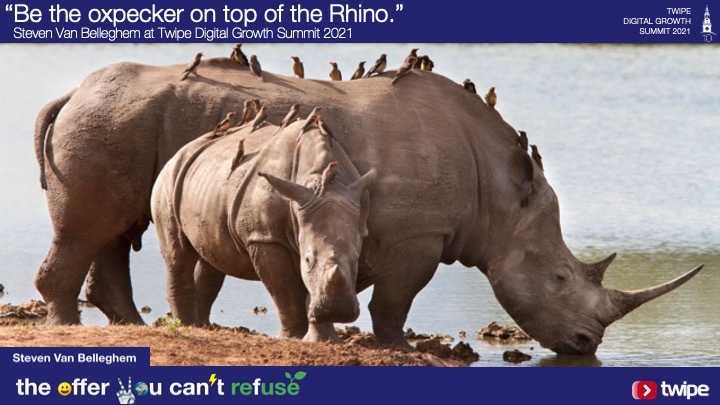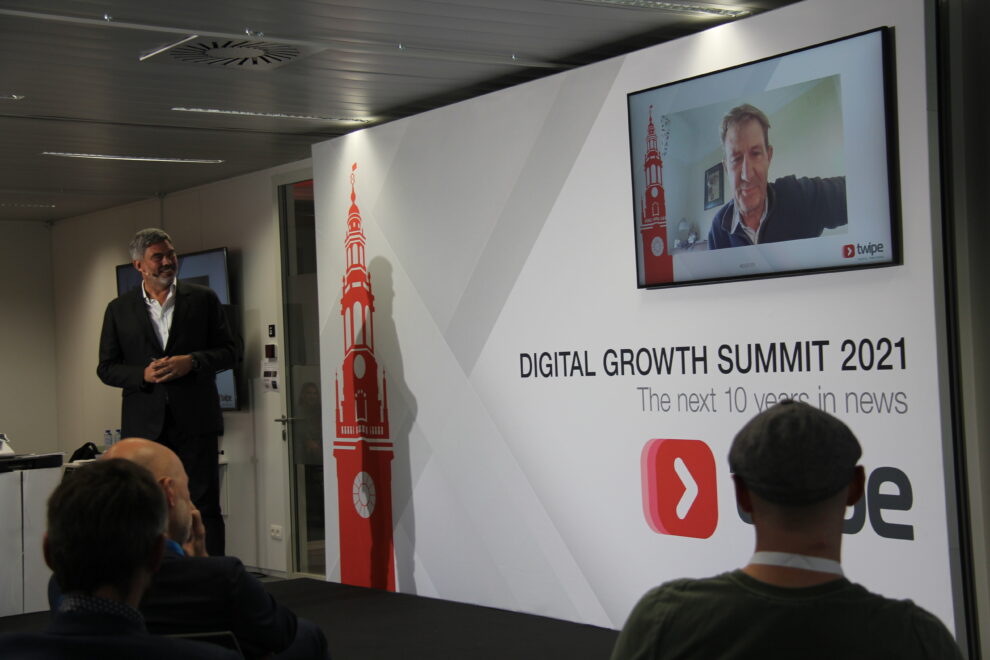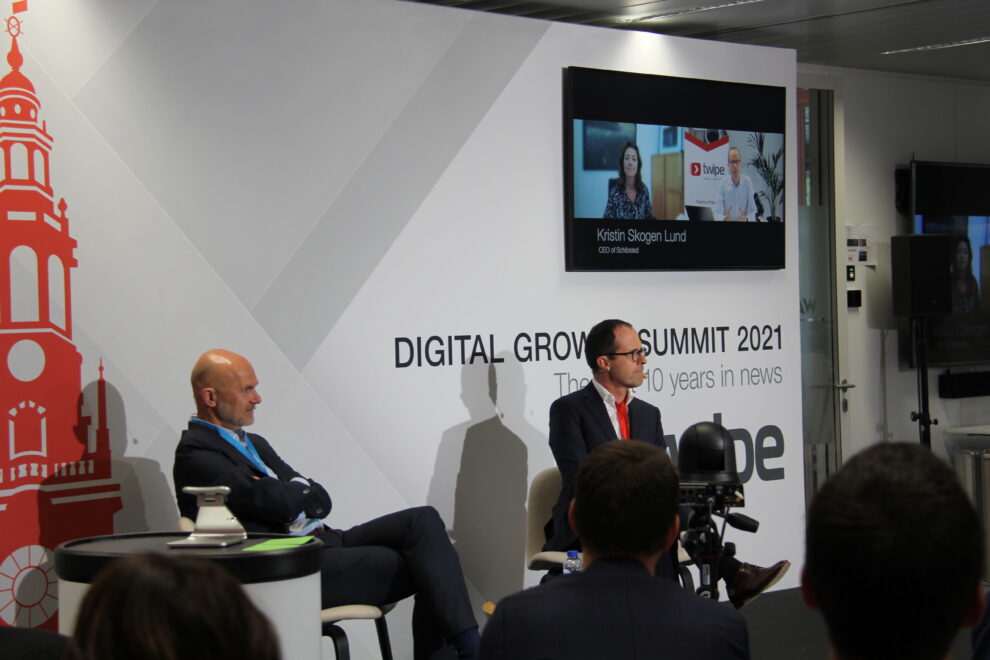Digital Growth Summit 2021 opened up the conversation on the next 10 years in news. Speakers and participants identified key trends, opportunities and challenges for the news industry. Our top 10 key takeaways from the summit are below.
1. News publishers have a unique opportunity to become a partner in life for their readers
Having a good relationship with your subscribers is about so much more than just providing them with a good digital experience. It is about becoming a partner in life for them. Becoming a partner in life may sound appealing, but it is a difficult feat to achieve.
For Steven Van Belleghem, Author of “The Offer You Can’t Refuse“, one of the Forbes 10 must read business books of 2020, news media need to be the oxpeckers living on top of the rhino. Oxpeckers pick up important signals, sometimes distant, sometimes invisible and broadcast them further to the rhino’s who are less well equipped by nature to pick up those sounds. That role can’t be fulfilled by technology. It will always have to be done by empathetic human beings. That’s where the opportunity for news media lies.

In his keynote speech, Steven van Belleghem told us that to be a partner in life, a publisher must:
- Be always around
- Never be intrusive
- Bring value
- Be there at the right moment
Get just one of these areas wrong, and then publishers risk losing subscribers. This an area which van Belleghem identified as an area that the tech giants have failed to expose. By becoming a partner in life, publishers must try to connect with the human behind the product. The human touch, even in the world of digital, is something that van Belleghem argued would become more important than ever. Here, publishers have the chance to build their relationship and go one step better than the tech giants.
On a personal note, Kristin Skogen Lund, CEO of Schibsted, also sees it as her personal challenge to have the Schibsted news brands play an even more important role in people’s personal lives in the next 10 years.
2. Back to basics in building deeper understandings of user needs
The newspaper used to be the go to place for everything. Be that weather, news about local sports teams or even adverts. News though, as Thomas Baekdal told the summit, is becoming a standalone product. People no longer come to news providers for non-news topics. For the weather, people now look at their weather apps. Thomas Baekdal pointed out, for gardening and horticulture, people now look for their favourite influencers who are focused on each niche. Publishers need to work to reclaim utility and fit back into people’s lives.
This is a great story of missed opportunities for the industry. Louise Story joined the summit to provide the example of New York city’s Turbovax. Huge Ma, a Software Engineer at AirnBnB, spent 3 weeks developing a tool that enabled residents on New York City to find the earliest COVID19 vaccine appointment available to them. For Story, this was a prime missed opportunity for a publisher. A publisher could’ve looked back to their traditional offerings and used this as a way to fit back into consumer’s lives. As an industry, we have to identify these opportunity and win back the utility space in people’s lives.
A limited number of publishers have noticed this trend and have started to leverage this. Thomas Baekdal provided the example of The New York Times who reinvented their cooking section. It is now a standalone product instead of having it intertwined with their news section. The New York Times cooking app is now responsible for 46% of The New York Times’ new subscriptions.
Peter Soetens CTO of Mediahuis referred to the User Needs model introduced by Dmitry Shishkin of the BBC and the need for publishers to collect more relevant data to have a detailed and data driven understanding of how to bring value to readers.

3. Better technology and data use will help rebuild trust and transparency
To help rebuild trust, new technologies and data uses built by the news industry for the news industry must be enhanced. Interestingly, Sacha Morard, CTO/CIO of Le Monde explained that innovation is not about being the best, but being the first. For this, there are many areas in which the news areas could be the first to get ahead of the tech giants and build greater trust in the news media.
The subject of first-party data was widely discussed at the summit. Peter Soetens explained how Mediahuis are working hard to translate their products into valuable data points so that they can better integrate with the lives of their subscribers. Other new technologies discussed to improve the future of the news industry included:
- Language models
- EU Cloud providers
- Green tech
- Easier feedback models beyond likes and dislikes
In the “Reimagining the future today” panel led by Raju Narisetti, Publisher at McKinsey Global Publishing, Jakub Parusinski from The Fix added that traditionally we have seen much of these technological innovators coming from Western Europe and the US, there are a great number of disruptors to watch coming out of the rest of the world. This was particularly because emerging markets will account for much more of the youth in next 10 years.
4. New product formats will be key to engage future generations
New formats may sound like a great idea, but what will they be? Future technologies will provide new product opportunities. As we have seen with the smartphone and to a lesser extent, the tablet, new products can drive engagement.
One format that has been leveraged recently by many publishers, and many argued could be the key way to win over new audiences, is audio. Katie Vanneck-Smith of Tortoise Media joined the summit to present the success of their new model of slow news. By releasing one article a week, an audio article, to subscribers alongside a daily newsletter, involving subscribers in the newsroom through thinkins, and releasing in-depth long-form audio articles in podcasts, they have been able to rethink the news. Interestingly, the summit heard that the average age of a Tortoise subscriber was just 29! Emma Tucker, Editor of The Sunday Times, also argued that it is conceivable that more news content delivered in audio rather than print next 10 years. She added that she found young people are still interested in the news, they just prefer it in audio form.
New formats also attract younger audiences. Gert Ysebaert highlighted that the recently introduced dedicated podcast apps of NRC in the Netherlands and De Standaard in Belgium, have attracted a particularly younger audience than the other offerings.
Bundling and unbundling the broken news will also play a key role in this development. As Steve Dempsey put it, we need to see the news as humpty dumpty. We must find out how we can put it together again. Dempsey presented the use of gratification theory (jobs to be done) to the summit as a key part of the future news product, alongside this bundling and unbundling. In the deep dive session, a mix of the 2 different theories was seen as a possible product the future.
Through project Nyss, Kaya Maraz, together with her team at the University of Oslo, have been working on designing the news app for Generation Z. We will share more about the insights Kaya prepared for the Digital Growth Summit in a follow up webinar.
5. Personalisation can make people fall in love with the news again
Despite bouncing back up by 6 percentage points, trust in the news is extremely low. A way to address this slump could be by gradually starting to give people the news that they want: personalisation.
The role and power of personalisation was something that both Kristin Skogen Lund and Gert Ysebaert identified as being extremely important for the future of news. Interestingly, whilst we know that personalisation has been started through various projects such as JAMES, Nic Newman argued that personalisation has already had a key impact. For him, this has particularly been in the area of newsletters. Steve Dempsey explained that one of the most powerful mixes to drive a habit-forming product could be through the use of personalisation and replicas – this is product area to watch out for in the future.

In fact, the role of personalisation in his deep dive session was explored thoroughly. One key suggestion was that to make people fall in love with the news again, consumers should be able to pick and choose the news they want from their own interest areas, much like the Sky TV bundle. This doesn’t necessarily use algorithms to track their reading. Instead, it gives them a wider range of stories on the areas that interest them, putting aside the risk of bias.
Whilst the use of personalisation was widely seen as a powerful tool for the industry and a way to make people fall in love with the new again, warnings were given to ensure that the right balance between news of the day and wholly personalised news is found. This balance would be vital to avoid filter bubbles and use the news to further their own views. Here, Sam Guzik called for personalisation to be used in a smart and transparent way.
Sacha Morard insisted on the need for publishers to have the highest level of transparency in how data is being used, for instance for personalisation. Technologies like GPT-3 have tremendous opportunities in the news industry. They will only be successful if they are understood and trusted by the readers.
6. Understanding and engaging new and younger audiences is the future of journalism
It has been said many times, but understanding and engaging new audiences is key to unlocking the successful subscriber model. The news industry has been guilty in resting on its laurels and failing to recognise the value of youth. In fact, the summit heard that the average age of a digital news subscriber is around 50 years old. This, clearly, is no shift away from the age of print news subscribers.
As a consequence, the ability of the news to appeal to younger audiences has become more difficult. With the richness of other sources available to provide free and fast news, young people simply don’t see paying for news as a necessity. To combat this, publishers must work hard to understand underrepresented audiences and appeal to them. In her deep dive session, Virginia Stagni and her participants found that some innovative ways to do this include:
- Better analytics and data to understand younger readers
- Getting influencers onboard to have partnerships with niche audiences
- Younger people in the newsrooms and across publishing companies
- Being the go-to place for news as opposed to social media
- New formats tailored to audiences
7. Rethinking our impact on society will help the industry standout
We are at a point in society where awareness of the issues facing our planet are at an all-time high. People want to feel like they’re helping the world… and they expect their providers to make a difference. Steven van Belleghem explained that ¾ of people want CEO’s of companies to take the lead.
In his speech, he told the summit that the publishing industry has untapped potential to have a positive influence in society through its reach and transformation. After highlighting that people are afraid to speak about the environment because of fear being incorrect and targeted for it, van Belleghem encouraged publishers to start by changing their world by using their core strength and being transparent with their efforts.
Kristin Skogen Lund insisted on the important role traditional news media will increasingly have as a safe and trusted haven of information. In a society overloaded by information and sometimes misinformed by influencers on the large platforms, she believe the news media will have an increasingly important role to play in a well informed democratic society.

8. Making news frictionless will help appeal to people’s live
Time is the most valuable thing for any consumer. Finding a way to fit into consumers lives as easily as possible is key. This has been adopted by many companies, such as Netflix with their “Skip Intro” button, or Belgian bank KBC through tools such as their in-app payments.
Steven van Belleghem stated that to win the subscription battle, news companies of the future must make themselves more time efficient and relevant. In doing so, they can become a partner in life when readers need it. After all, the more publishers respect the time of their customers, the more time customers will give to you.
Steven believes that other industries besides the tech giants, will also evolve towards becoming content publishers. The example of KBC mobile, the mobile banking app of Belgian KBC Bank, which has recently started to give its users free access to football results and short videos was eye opening. He also added that this can work the same way with news publishers. Publishers can dare to expand outside of their traditional areas. The boundaries for companies of the future could be limitless.
9. People are willing to pay for news so we should have hope
The willingness of people to pay for news is increasing. Not just did data from Nic Newman at Reuters suggest this, but this positive trend was reiterated by Kristin Skogen Lund from Schibsted and Daniel Daum of Rheinische Post, who explained that Rheinische Post titles had seen an 81% increase in paid digital subscribers since 2019. In fact, Kristin announced that Schibsted have become digitally sustainable, meaning their editorial team could be funded by digital subscriber revenue alone. Markus Schöberl added that the publishing industry shouldn’t be concerned about an upper limit of people willing to pay for news. Instead publishers could take hope from the fact that the appeal of their news is exponential.
Whilst the trend was seen to be particularly high in the Scandinavian countries, where 28% paid for news, the figures across the board represented a positive shift. This willingness to pay, it is important to say, was seen as part of a winner takes most dynamic. Larger players in the market such as the New York Times and the Telegraph currently benefit more than others. A positive trend however, is occurring of people taking out more than 1 subscription. Nic Newman explained that this was often for 1 large title and 1 smaller or more niche title.
We also heard from Nic Newman that this shift in the direction of paying for news was driven by the desire for accurate, fact-based news during the pandemic. Making this stick could provide a key slice of hope for the industry. On a very positive note, we also learned from Sophie Cassam Chenaï, CDO of Le Parisien, that they have recently seen a better conversion rate on positive news, rather than negative news.

10. Do all these things right then we will be able to compete with the tech giants
One of the most hotly discussed topics at this year’s Digital Growth Summit was the role of the tech giants. Whilst Gert Ysebaert and Kristin Skogen Lund both identified that we had underestimated their influence, their grip on society and the digital industry is undeniable. Their influence has truly had an impact of the future of publishers, with Kristin adding that through their in-app subscriptions, Apple currently take 30% of subscription revenue. Alongside doing this, they obstruct publishers’ opportunity to build a relationship with their customers by encrypting customer data. Kristin highlighted that it will be interesting to follow legislation, in particular the EU’s Digital Markets Act and Digital Services Act, to see the impact on competition in the European Publishing market.
CEO of Les Echos/Le Parisien Pierre Louette also spoke out about the threat of what he coined as “California Barbarians”. His book “Of Giants and Men” uncovered the impact of the tech giants in the industry and found out how they have used their skills to destroy so much of their surroundings. In his presentation, Pierre called for people to raise greater awareness and education around the role of the tech giants to ensure a fair level of competition.
Tech-giants acting as a barrier between publishers and subscribers is something that publishers must work hard to combat and something that the summit agreed would be of paramount importance for publishing going forwards.
Louise Story however pointed out that newspapers should become more like tech companies and further increase their product, data and tech capabilities.
